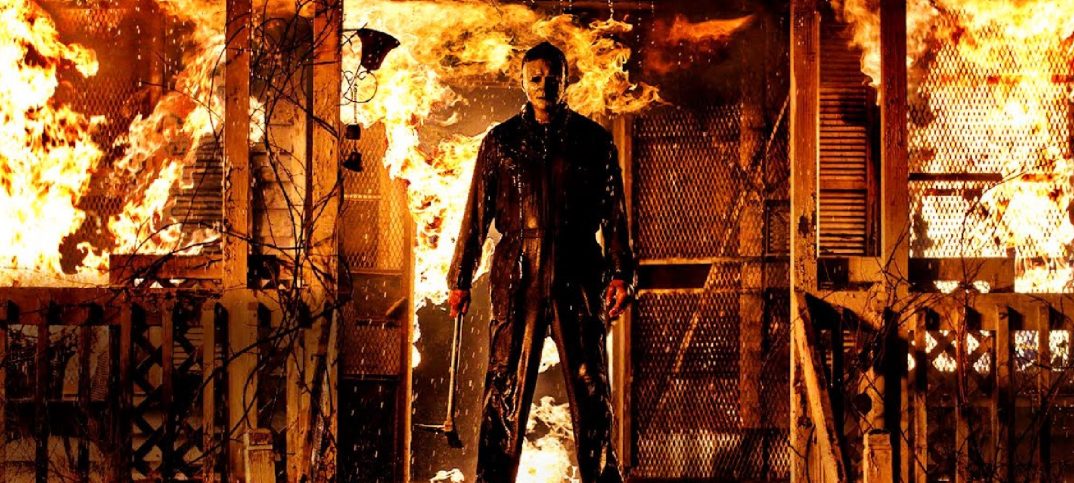Reviewed by Jeffrey Sanzel
The Halloween franchise boasts eleven films, including seven in the first series (with the third an unconnected entry), a reboot, and a continuation of its premiere track. The most recent, Halloween (2018), is now joined by Halloween Kills.

While falling into the category of “slasher movie,” Halloween (1978) remains one of the finest thrillers. Taut, brooding, and atmospheric, it relied on shadows, tension, and an unforgettable score to create its horror. John Carpenter directed and co-wrote the film that remains definitive in the genre. In addition, the film catapulted its lead, Jamie Lee Curtis, to Scream Queen stardom. She presented Laurie Strode as a self-actualized and resourceful heroine. Curtis would reprise the role four more times in addition to Halloween Kills and Halloween Ends (projected for release in 2022).
Ignoring much of the mythology developed during the progressively less inspired sequels, the well-received Halloween (2018) picked up forty years after the original film, with institutionalized killer Michael Myers (once again Nick Castle and James Jude Courtney) escaping while being transferred to a maximum-security prison. After returning to Haddonfield and embarking on a killing spree, he “dies” in Laurie’s burning home. The film emphasized Laurie as a wounded survivor, finding the inner strength to confront her living nightmare. The script—by Jeff Fradley, Danny McBride, and David Gordon Green—honored the story’s roots. Carpenter praised the outing, noting the strength of the screenplay and Green’s direction.
It would be easy to say things like Halloween Kills … an hour and forty-six minutes of your life. Or Halloween Kills … the desire to go to the movies. Or Halloween Kills … a franchise. It would be easy to pick this low-hanging fruit. So, I won’t say any of those things.
Halloween Kills is a movie cobbled together with brutal violence and an absence of actual conflict. It serves as a placeholder between the first film, which reintroduced the characters, and the third (and hopefully final) chapter that concludes Laurie’s journey. That Michael Myers must survive to complete the trilogy is a given. Nevertheless, it does not need to be so painfully generic. In the first fifteen minutes, Michael slaughters an entire team of first responders. What follows is one meaningless killing after another.
The film makes the egregious error of showing flashbacks to the Halloween (and Halloween) of 1978. However, these newly shot scenes lack the meditative, shadowed world of the original. Instead, they are overwrought, introducing information with only the slightest nod towards character development. Additionally, the use of footage of Donald Pleasance (the powerful, understated Dr. Loomis of the source film) is a reminder of the complete absence of style and substance in this newest incarnation.
Having been stabbed in the abdomen, Laurie spends almost the entire film in a hospital bed (shades of Halloween II’s hospital location). Sidelining the strongest character is a mistake. Saddling an actor of Jamie Lee Curtis’s caliber with embarrassingly clumsy dialogue is a crime.
The roster of townspeople is a mix of new characters and shout-outs to minor characters in the original. Some of the 1978 cast returns to play themselves forty years later; others are the grown-up versions of the children hunted that fateful night.
Anthony Michael Hall is the adult Tommy, the boy Laurie was babysitting. The role edges to slightly more than one dimension. At a bar talent night(!), Tommy shares the story of “The Bogeyman,” who terrorized the town. His character misfires on every level, trading trauma for campfire whimsy and rally-round-the-pitchfork-boys. Among the new victims for the stalk-dispatch-repeat are an African American couple (she’s a doctor; he’s a nurse) and a gay couple (Big John and Little John). Please don’t get too invested in the diversity; they are all undefined fodder for the knife.
Worst of all, in a nod to topicality, the creators introduce the dangers of mob mentality and vigilante justice. “Evil dies tonight!” they chant. Multiple times. Declarations such as “No, he’s turning us into monsters,” “The more he kills, the more he transcends,” and “He is the essence of evil” don’t elevate the situation.
The performances never overstep the awkward script. Judy Greer (as Karen Nelson, Laurie’s daughter), Andi Matichak (as Allyson Nelson, Laurie’s granddaughter), and Will Patton (as Deputy Frank Hawkins) continue their paths from Halloween (2018). Greer, a talented actor, is a cipher. It is also hard to believe that her husband was murdered by Michael this same night. It is as if the year between the release of the films has allowed her to accept it. The storyline and timeline are bizarrely disconnected.
For those looking for a predictable, sadistic bloodbath, Halloween Kills might be for you. But, for those hoping for plot, motivation, thought, tone, and engagement … well, there’s always next Halloween. Rated R, the film is now playing in local theaters.
—————————————–
Other seasonal fair to consider: the Candyman reboot; Malignant, the twisty thriller from James Wan; Lamb, the story of a human/sheep hybrid; Last Night in Soho, a psychological time-travel film with a horror overtone; malevolent forces in Shepherd; and the supernatural creature-feature Antlers, starring Keri Russell. (Please note: These films have not been reviewed by TBR News Media.)







